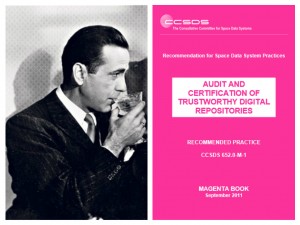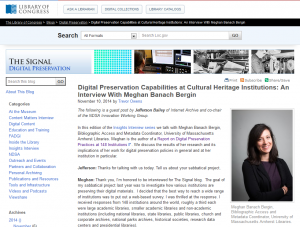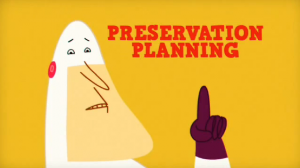Hi everyone, Shira here. Today’s blog post will be something of a project update by way of some thoughts about the need for digital preservation policies, inspired by a conversation between Jefferson Bailey and Meghan Banach Bergin that went up on the Signal earlier this week. Meghan is the author of a Report on Digital Preservation Practices at 148 Institutions worldwide, and Jefferson interviewed her to discuss the results of her research and its implications on her work at University of Massachusetts Amherst Libraries, where Meghan works as the Bibliographic Access and Metadata Coordinator.
Bergen’s report provides a fascinating snapshot of how digital preservation is being done around the world at this particular moment in time. Specifically, it highlights the extreme degree of variation that exists within the field; although there are some common themes among digital preservation initiatives (tight budgets, imperfect tools, and not enough members of staff), no two institutions have an approach to preserving digital information that is exactly alike.
For me, one of the most compelling insights to emerge from Bergen’s report is the fact that over 90% of respondents said that they had undertaken efforts to preserve digital materials, and yet only about 25% of the institutions surveyed had a written digital preservation policy. (Briefly, for those wondering what a digital preservation policy is: it’s a written statement authorized by the repository management describing the approach to be taken for the preservation of digital objects deposited into the repository). When I first read that statistic I found it somewhat shocking, but the longer I sat with it the less surprising it began to seem. In fact, I realized that it chimed with my own experience working in the field, which led me to reflect on why this has come to be the case for so many institutions.
The first reason I hit upon is one that Bergen herself mentions in her interview with Bailey. When he asks her about what she feels accounts for the discrepancy, Bergen says that writing a digital preservation policy is time consuming, and that, “that’s why a lot of institutions have decided to skip writing a policy and just proceed straight to actually doing something to preserve their digital materials.”
This struck me as a particularly revealing sentiment because it implies that many respondents understand the act of writing a high-level digital preservation policy document to be fundamentally different (and inherently less valuable) than “actually doing something” to preserve their collections. Quite frankly, this is something that needs to change. Institutions need to begin approaching digital preservation as a holistic task rather than as a series of actions that fulfill the basic preservation requirements of bit preservation and content accessibility. There needs to be a deeply ingrained understanding that not only must any archive, museum, or library seeking to preserve digital material commit to implementing these high-level policy documents, but that doing so is digital preservation in and of itself.
Of course I understand that there is a practical difference between high-level conceptual planning and the hands-on tasks involved in the day-to-day management of an ever-growing collection of digital information; I have yet to work at a repository that has ever had the luxury of ever operating completely outside of the triage stage, and at any given time finding a balance between meeting users’ and administrations’ needs—not to mention the collections’—can be a challenge.
But there will always be emergencies, deadlines, and budget cuts. In fact, that is part of what makes having a digital preservation policy in place so important: being able to articulate your repository’s approach for the preservation of objects accessioned into it will provide a strategy that may help identify gaps or areas of weakness in your preservation strategy, which will in turn help repositories be better prepared for an emergency if one should occur. A good preservation policy may also aid in demonstrating that certain positions are vital to the organization’s mission, or even—if paired with a well-constructed strategic survey of user groups—help determine the repository’s worth to an organization. In short, this is why having a digital preservation policy is considered a prerequisite to becoming a Trustworthy Digital Repository (for more on that subject see my previous blog post, On The Subject of Trust, which discusses why this matters)
Digital preservation policies matter, and I feel lucky to have the opportunity to help Carnegie Hall draft one. The final deliverable for my NDSR project will be a Digital Preservation and Sustainability document for Carnegie Hall that will outline a set of policies, procedures, best practices, and workflows for the ongoing management of digital files. And yes, this will ultimately include a digital preservation policy, as well as a Preservation Implementation Plan, Strategic Plan, Repository Mission Statement, and Access Policy. (Here’s lookin’ at you, TDR)

At this point in my project I’m midway through the process of gathering the information I will need to eventually create this document. I’ve spent the past month interviewing a variety of different departments across Carnegie Hall to determine how digital content is being created, used, stored, and managed within the organization. I’ve learned a great deal; talking to people has provided me with not only a better understanding of how digital content used within Carnegie Hall, but it has also given me the opportunity to learn what matters most to each department, which will be crucial when we begin rolling out the new DAMS next year. Currently I’m in the process of reviewing, synthesizing, and summarizing these interviews. I will return to these interviews over the next couple months as my project progresses and I reach a point where I can begin to document some of the workflows described in them, so watch this space for updates.
***
Further Reading: There is a lot of good information and resources available on this subject, but wanted to give a quick h/t to Daniel Noonan’s “Digital Preservation Policy Framework: A Case Study”, which charts the process through which The Ohio State University Libraries created an organizational policy for digital information. I particularly enjoyed reading this case study and highly recommend giving it a read.


